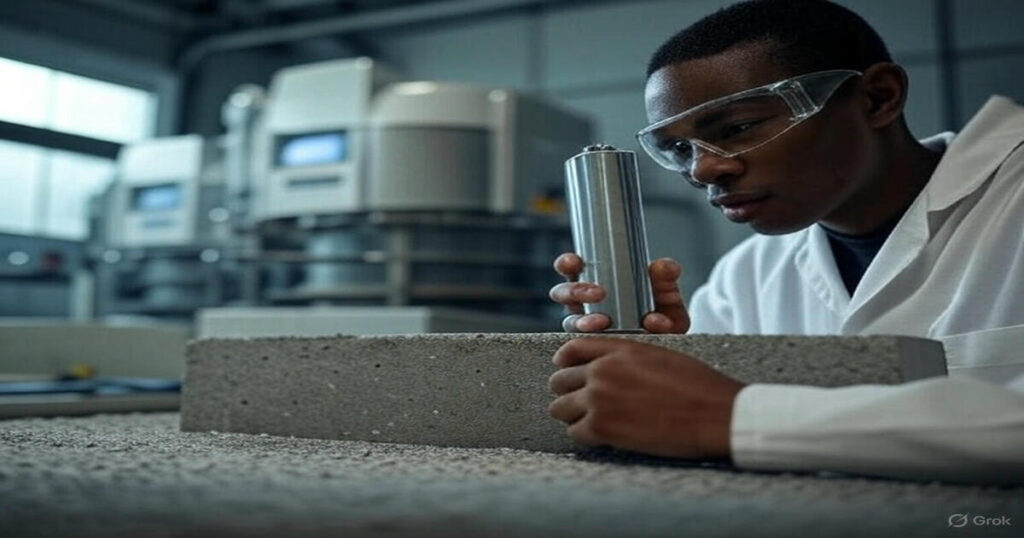Introduction
Concrete is the backbone of modern infrastructure, offering strength, durability, and versatility. However, its performance heavily depends on various factors, one of which is air content. Measuring the air content in concrete is critical to ensuring its freeze-thaw resistance, durability, and overall structural integrity. This blog post explores the importance of air content, various testing methods, standard practices, and tips for accurate measurement.
What is Air Content in Concrete?
Air content refers to the volume of air voids within a concrete mix, expressed as a percentage of the total volume. These air voids can be:
- Entrapped air: Unintentional and irregular voids formed during mixing.
- Entrained air: Deliberately added tiny, uniformly distributed bubbles created using air-entraining agents.
Entrained air improves the concrete’s workability and resistance to freeze-thaw cycles, which is essential in colder climates.
Why Measuring Air Content is Important
Proper air content in concrete directly affects the following properties:
- Durability: Prevents cracking and scaling due to freeze-thaw action.
- Workability: Enhances ease of placement and compaction.
- Strength: Too much air reduces compressive strength; too little compromises durability.
- Finish Quality: Helps avoid surface defects and honeycombing.
Maintaining the optimal range of 4%–8% air content (depending on mix design and exposure conditions) is critical for performance and longevity.
Standard Methods for Measuring Air Content in Concrete
Several test methods are commonly used to measure air content. Each has its advantages and is selected based on the type of concrete and the project requirements.
1. Pressure Method (ASTM C231)
Best for: Normal weight concrete
This is the most widely used method in field conditions. It involves placing fresh concrete in a pressure meter, applying air pressure, and observing the pressure drop to determine the volume of air.
Advantages:
- Quick and reliable
- Portable equipment
- Suitable for routine field use
Limitations:
- Not suitable for lightweight concrete
- Requires calibration for accuracy
2. Volumetric Method (ASTM C173)
Best for: Lightweight and air-entrained concrete
This method involves agitating a known volume of concrete with water and isopropyl alcohol in a volumetric meter. The displaced water is measured to determine air content.
Advantages:
- Accurate for all types of concrete, including lightweight
- Direct measurement
Limitations:
- More time-consuming
- Requires careful execution to avoid errors
3. Gravimetric Method (ASTM C138)
Best for: Laboratory settings and small-scale samples
Also known as the unit weight method, this test calculates air content by comparing the theoretical density of concrete with its actual measured density.
Advantages:
- No specialized equipment needed
- Useful for confirming other methods
Limitations:
- Less accurate for air-entrained concrete
- Sensitive to measurement errors
Step-by-Step Guide to Pressure Method (ASTM C231)
- Sample Collection: Obtain a representative sample of fresh concrete.
- Filling the Meter: Place concrete into the pressure meter in layers, rodding each layer to eliminate large air voids.
- Apply Pressure: Seal the lid, pump to a predetermined pressure, and stabilize the gauge.
- Read Gauge: The gauge reading corresponds to the air content.
- Adjust for Calibration: Correct the reading based on the calibration curve.
Factors Affecting Air Content
Several factors influence the accuracy and variability of air content in concrete:
- Mix Design: Water-cement ratio, aggregate size, and admixtures all play a role.
- Mixing Time: Over- or under-mixing can change air content.
- Ambient Conditions: Temperature and humidity affect air retention.
- Transport and Placement: Vibration and pumping can reduce air content.
Best Practices for Accurate Measurement
- Calibrate Equipment Regularly: Ensure gauges and meters are calibrated as per standards.
- Test Immediately: Perform tests as soon as the concrete is sampled to avoid air loss.
- Avoid Over-Vibration: Excessive vibration during sample preparation can artificially reduce air content.
- Use Clean Equipment: Residues or hardened concrete can interfere with accurate readings.
- Document Everything: Record test conditions, mix details, and air content results for quality assurance.
Common Mistakes to Avoid
- Using the wrong test method for the concrete type
- Failing to properly rod or tamp concrete in the container
- Neglecting calibration of pressure or volumetric meters
- Misreading or misinterpreting gauge readings
Proper training and attention to detail are essential for reliable air content measurements.
Air Content Specifications and Tolerances
Air content requirements vary depending on exposure conditions and project specifications. For instance:
- Severe exposure (freeze-thaw, deicing salts): 5%–8% air
- Moderate exposure: 4%–6% air
- Mild exposure: 2%–4% air
Tolerances typically allow ±1.5% deviation from the target value, but always refer to ACI 318 and project-specific specifications for compliance.
Conclusion
Measuring air content in concrete is a critical quality control process that ensures durability, performance, and compliance with design requirements. Whether you’re a site engineer, lab technician, or contractor, understanding the right testing method and executing it properly can significantly affect the success of your concrete project.
By using standardized methods like ASTM C231, C173, and C138, following best practices, and avoiding common pitfalls, you can maintain high-quality concrete that stands the test of time.

